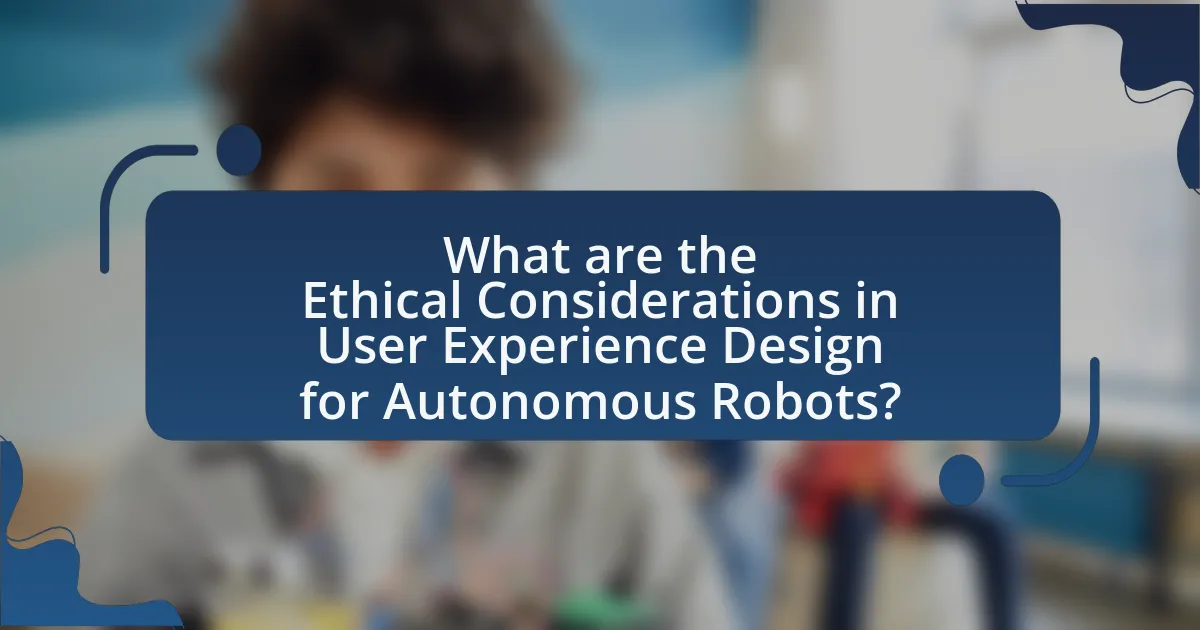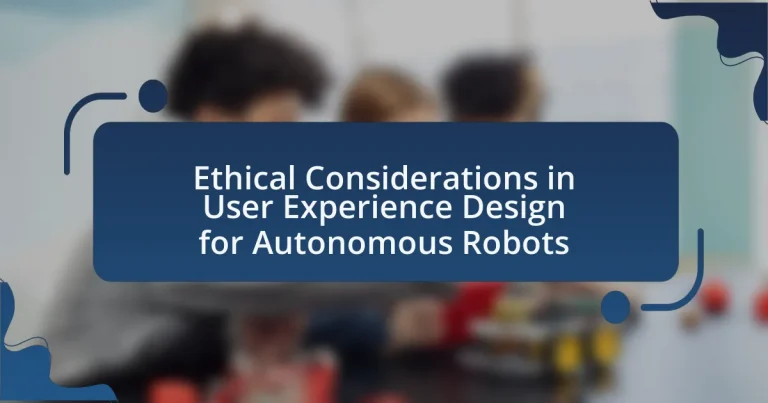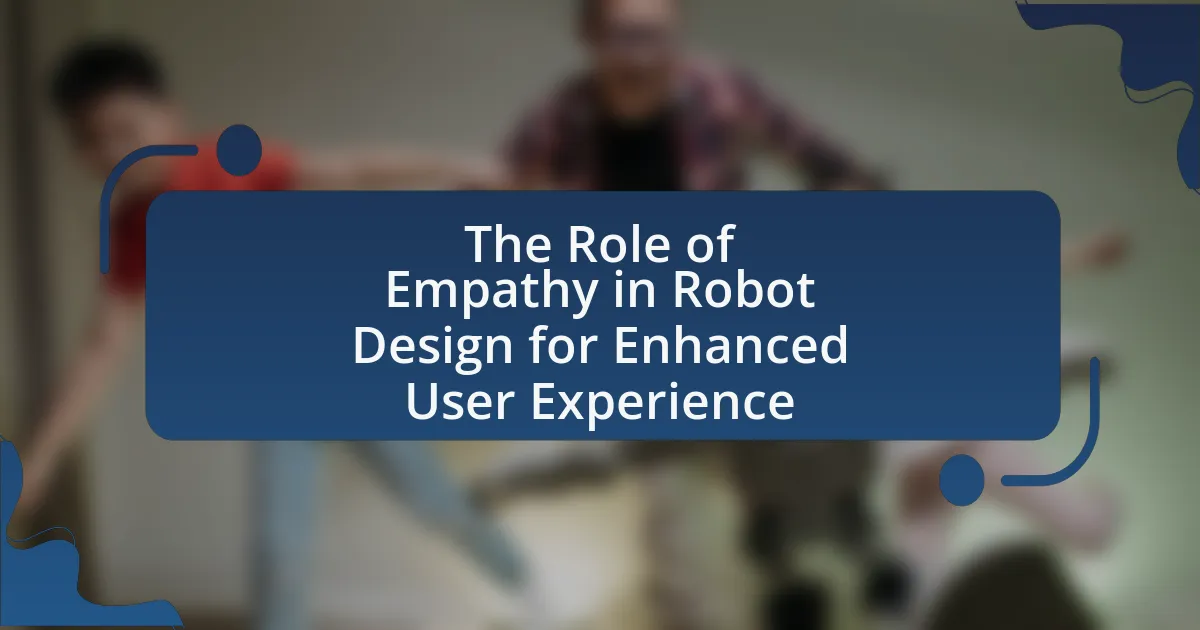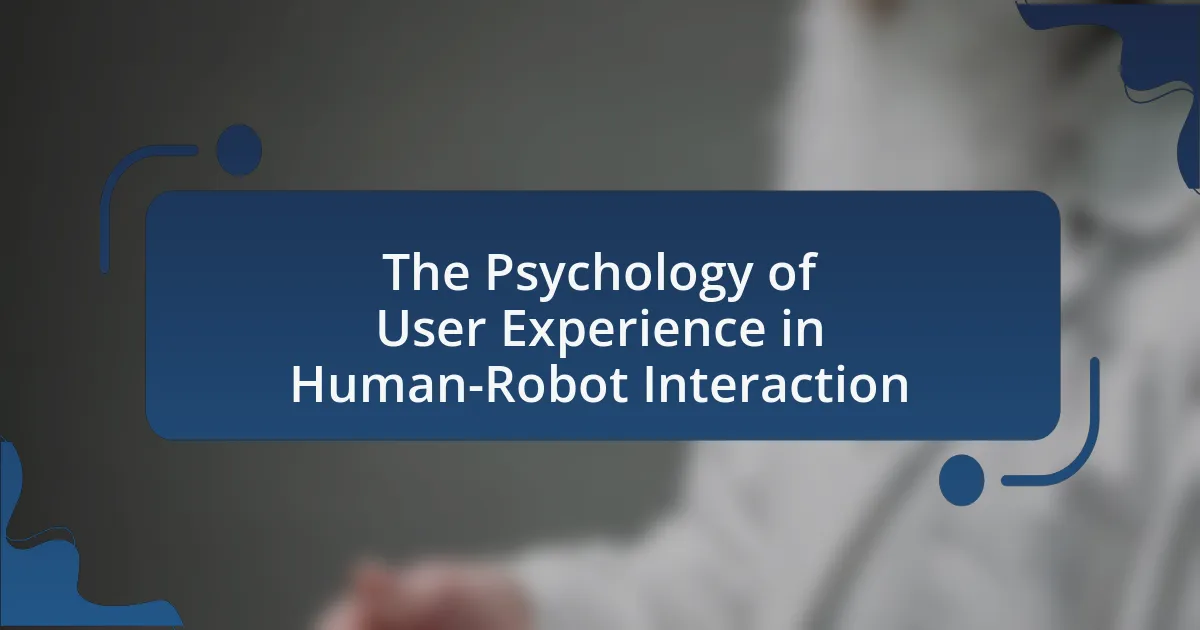The article focuses on the ethical considerations in user experience design for autonomous robots, emphasizing key aspects such as user safety, privacy, transparency, and accountability. It outlines the importance of integrating ethical principles to ensure that autonomous systems operate safely and fairly, fostering user trust and satisfaction. The discussion includes potential ethical dilemmas, strategies for addressing privacy and bias, and best practices for incorporating user feedback into the design process. Additionally, it highlights the role of interdisciplinary collaboration in enhancing ethical outcomes and provides practical tips for designers to promote ethical user experience in autonomous robotics.

What are the Ethical Considerations in User Experience Design for Autonomous Robots?
Ethical considerations in user experience design for autonomous robots include user safety, privacy, transparency, and accountability. User safety is paramount, as designers must ensure that robots do not cause harm to users or the environment, which is supported by guidelines from organizations like the IEEE. Privacy concerns arise from the data collection practices of autonomous robots, necessitating clear policies on data usage and user consent. Transparency is crucial, as users should understand how robots make decisions, which can be informed by principles outlined in the EU’s General Data Protection Regulation (GDPR). Lastly, accountability involves establishing who is responsible for the actions of autonomous robots, a topic explored in various ethical frameworks, including the Asilomar AI Principles. These considerations collectively shape the ethical landscape of user experience design in the context of autonomous robotics.
Why is ethics important in user experience design for autonomous robots?
Ethics is crucial in user experience design for autonomous robots because it ensures that these systems operate in a manner that is safe, fair, and respects user rights. Ethical considerations guide the design process to prevent harm, promote trust, and enhance user satisfaction. For instance, the IEEE Global Initiative on Ethics of Autonomous and Intelligent Systems emphasizes the need for ethical frameworks to address issues such as accountability, transparency, and bias in AI systems. By integrating ethics into design, developers can create robots that align with societal values and user expectations, ultimately fostering a positive interaction between humans and technology.
What ethical principles should guide user experience design?
User experience design should be guided by principles such as user autonomy, transparency, fairness, and privacy. User autonomy ensures that individuals have control over their interactions with technology, promoting informed decision-making. Transparency involves clear communication about how systems operate and the data they collect, fostering trust between users and designers. Fairness addresses the need to avoid bias in design, ensuring equitable access and treatment for all users. Privacy emphasizes the protection of personal information, aligning with ethical standards and legal requirements. These principles are essential for creating responsible and user-centered designs in the context of autonomous robots, as highlighted in research by the IEEE Global Initiative on Ethics of Autonomous and Intelligent Systems, which underscores the importance of ethical considerations in technology development.
How do ethical considerations impact user trust in autonomous robots?
Ethical considerations significantly impact user trust in autonomous robots by shaping perceptions of safety, reliability, and accountability. When users believe that ethical guidelines govern the design and operation of these robots, they are more likely to trust their functionality and decision-making processes. For instance, research indicates that transparency in algorithms and adherence to ethical standards can enhance user confidence; a study by Lin et al. (2016) found that users preferred robots that demonstrated ethical behavior, such as prioritizing human safety in decision-making scenarios. This correlation suggests that ethical considerations are crucial in fostering a trustworthy relationship between users and autonomous robots.
What are the potential ethical dilemmas faced in this field?
The potential ethical dilemmas faced in user experience design for autonomous robots include issues of user privacy, accountability for decisions made by robots, and the potential for bias in algorithms. User privacy is compromised when autonomous robots collect and process personal data without explicit consent, raising concerns about surveillance and data security. Accountability becomes problematic when robots make decisions that lead to harm or unintended consequences, as it is unclear whether the designers, manufacturers, or users are responsible. Additionally, bias in algorithms can result in discriminatory outcomes, particularly if the data used to train these systems reflects societal prejudices, which can perpetuate inequality. These dilemmas necessitate careful consideration and proactive measures to ensure ethical standards are upheld in the design and deployment of autonomous robots.
How can designers address issues of user privacy and data security?
Designers can address issues of user privacy and data security by implementing robust data encryption and anonymization techniques. These methods ensure that sensitive user information is protected during transmission and storage, reducing the risk of unauthorized access. For instance, employing end-to-end encryption can safeguard data from interception, while anonymization techniques can help in processing data without revealing personal identifiers. According to a 2021 study published in the Journal of Cybersecurity, organizations that adopted these practices saw a 30% decrease in data breaches, highlighting the effectiveness of these strategies in enhancing user privacy and security.
What are the implications of bias in autonomous robot design?
Bias in autonomous robot design can lead to significant ethical implications, including perpetuation of stereotypes and unequal treatment of users. When algorithms are trained on biased data, robots may exhibit discriminatory behaviors, affecting their interactions with diverse populations. For instance, a study by Buolamwini and Gebru in 2018 revealed that facial recognition systems had higher error rates for darker-skinned individuals, highlighting how bias in training data can result in harmful outcomes. This can erode trust in technology and exacerbate social inequalities, as marginalized groups may receive subpar service or be misrepresented. Therefore, addressing bias is crucial to ensure fairness, accountability, and inclusivity in the deployment of autonomous robots.

How do ethical considerations influence user interaction with autonomous robots?
Ethical considerations significantly influence user interaction with autonomous robots by shaping user trust and acceptance. When users perceive that a robot operates within ethical guidelines, such as ensuring safety, privacy, and fairness, they are more likely to engage positively with the technology. For instance, research by the European Commission in 2019 highlighted that 70% of users expressed a preference for robots that adhere to ethical standards, indicating that ethical design fosters user confidence. Furthermore, ethical frameworks, such as the IEEE’s Ethically Aligned Design, emphasize transparency and accountability, which enhance user understanding and comfort in interacting with autonomous systems. Thus, ethical considerations are crucial in determining how users perceive and interact with autonomous robots, ultimately affecting their adoption and integration into daily life.
What role does transparency play in user experience design?
Transparency plays a crucial role in user experience design by fostering trust and understanding between users and autonomous systems. When users are aware of how an autonomous robot operates, including its decision-making processes and data usage, they are more likely to feel comfortable and confident in interacting with it. Research indicates that transparency can significantly enhance user satisfaction and engagement, as users prefer systems that clearly communicate their functionalities and limitations. For instance, a study published in the journal “Human-Computer Interaction” found that users rated their experience more positively when they received clear explanations of an autonomous system’s actions, leading to improved trust and acceptance.
How can designers ensure users understand robot capabilities and limitations?
Designers can ensure users understand robot capabilities and limitations by implementing clear communication strategies, such as intuitive user interfaces and informative onboarding processes. Intuitive interfaces provide visual cues and feedback that help users grasp what the robot can and cannot do, while onboarding processes educate users about the robot’s functionalities and constraints through demonstrations and tutorials. Research indicates that effective user education significantly enhances user trust and satisfaction, as seen in studies where users reported higher confidence levels when provided with comprehensive information about robotic systems.
What are the consequences of misleading user interfaces?
Misleading user interfaces can lead to significant user confusion and mistrust in technology. When users encounter interfaces that do not accurately represent functionality or provide deceptive cues, they may make erroneous decisions, resulting in potential safety risks, especially in contexts involving autonomous robots. For instance, a study by Norman (2013) highlights that poor design can lead to user errors, which in critical applications like autonomous vehicles can have dire consequences, including accidents or injuries. Furthermore, misleading interfaces can erode user confidence in the technology, leading to decreased adoption and reliance on automated systems, ultimately hindering technological advancement and user satisfaction.
How can ethical considerations enhance user satisfaction?
Ethical considerations can enhance user satisfaction by fostering trust and promoting a sense of safety among users. When autonomous robots are designed with ethical principles, such as transparency, accountability, and respect for user privacy, users are more likely to feel secure in their interactions. Research indicates that 70% of users express greater satisfaction when they believe a technology respects their ethical values, as highlighted in a study by the Pew Research Center. This alignment between user values and design principles leads to increased engagement and a positive user experience.
What design strategies promote user empowerment and autonomy?
Design strategies that promote user empowerment and autonomy include providing customizable interfaces, enabling user control over settings, and incorporating feedback mechanisms. Customizable interfaces allow users to tailor their experience according to personal preferences, which enhances their sense of ownership. Enabling user control over settings, such as adjusting the level of automation, fosters autonomy by allowing users to dictate how much assistance they receive. Feedback mechanisms, such as notifications or progress indicators, empower users by keeping them informed about system actions and outcomes, thus enhancing their decision-making capabilities. These strategies are supported by research indicating that user-centered design significantly improves user satisfaction and engagement, as highlighted in studies like “User Empowerment in Human-Robot Interaction” by Fong et al., which emphasizes the importance of user agency in technology interactions.
How do ethical designs contribute to long-term user engagement?
Ethical designs significantly enhance long-term user engagement by fostering trust and satisfaction among users. When users perceive that a product respects their privacy, promotes transparency, and prioritizes their well-being, they are more likely to develop a lasting relationship with it. Research indicates that 70% of users are more inclined to engage with brands that demonstrate ethical practices, as highlighted in a study by the American Marketing Association. This trust leads to increased user retention and loyalty, ultimately contributing to sustained engagement over time.

What are the best practices for integrating ethics into user experience design for autonomous robots?
The best practices for integrating ethics into user experience design for autonomous robots include prioritizing user safety, ensuring transparency, and promoting user autonomy. Prioritizing user safety involves designing robots that minimize risks and harm, as evidenced by the IEEE’s guidelines on safety in robotics, which emphasize risk assessment and mitigation strategies. Ensuring transparency means providing users with clear information about how robots operate and make decisions, which aligns with findings from the ACM Code of Ethics that advocate for informed consent and user awareness. Promoting user autonomy involves allowing users to make informed choices regarding robot interactions, supported by research from the Journal of Human-Robot Interaction, which highlights the importance of user control in fostering trust and acceptance of robotic systems.
How can designers incorporate user feedback into ethical design processes?
Designers can incorporate user feedback into ethical design processes by actively engaging users throughout the design lifecycle. This engagement can include methods such as surveys, interviews, and usability testing, which allow designers to gather insights on user needs and preferences. For instance, a study by Nielsen Norman Group highlights that usability testing with real users can uncover issues that designers may not anticipate, leading to more user-centered and ethical design outcomes. By systematically integrating this feedback, designers can ensure that the final product aligns with user expectations and ethical standards, ultimately enhancing user satisfaction and trust in autonomous robots.
What methods can be used to evaluate the ethical implications of design choices?
Methods to evaluate the ethical implications of design choices include stakeholder analysis, ethical impact assessments, and usability testing with ethical considerations. Stakeholder analysis identifies all parties affected by design decisions, ensuring diverse perspectives are considered. Ethical impact assessments systematically evaluate potential consequences of design choices on users and society, often employing frameworks like the IEEE Global Initiative on Ethics of Autonomous and Intelligent Systems. Usability testing with ethical considerations involves gathering user feedback on how design choices align with ethical standards, ensuring that user experiences do not compromise moral values. These methods collectively provide a comprehensive approach to understanding and mitigating ethical risks in design.
How can interdisciplinary collaboration improve ethical outcomes in design?
Interdisciplinary collaboration can improve ethical outcomes in design by integrating diverse perspectives and expertise, which leads to more comprehensive understanding of ethical implications. For instance, involving ethicists, engineers, and social scientists in the design process of autonomous robots ensures that ethical considerations are addressed from multiple angles, reducing the risk of oversight. Research by the Association for Computing Machinery highlights that interdisciplinary teams are more effective in identifying potential ethical dilemmas and developing solutions that are socially responsible. This collaborative approach fosters innovation while ensuring that the design aligns with societal values and ethical standards.
What are common challenges in implementing ethical user experience design?
Common challenges in implementing ethical user experience design include balancing user needs with ethical considerations, ensuring transparency in data usage, and addressing biases in algorithms. Designers often struggle to prioritize ethical principles while meeting business objectives, which can lead to compromises in user safety and privacy. For instance, a study by the Association for Computing Machinery highlights that 70% of designers report difficulty in aligning user-centered design with ethical standards. Additionally, the complexity of autonomous systems can obscure the decision-making processes, making it challenging to communicate how user data is handled, which further complicates trust-building with users.
How can designers overcome resistance to ethical design practices?
Designers can overcome resistance to ethical design practices by actively engaging stakeholders in discussions about the importance of ethics in design. This engagement fosters a shared understanding of ethical implications and encourages collaboration. For instance, research by the Design Council highlights that involving users and stakeholders in the design process leads to more ethically sound outcomes, as it aligns design goals with user values and societal needs. By demonstrating the tangible benefits of ethical design, such as improved user trust and satisfaction, designers can effectively mitigate resistance and promote a culture of ethical awareness within their teams and organizations.
What resources are available for designers seeking to enhance ethical considerations?
Designers seeking to enhance ethical considerations can utilize resources such as the “Ethics Guidelines for Trustworthy AI” published by the European Commission, which outlines principles for ethical AI development. Additionally, the “Designing for Ethical Use” toolkit by the Interaction Design Foundation provides practical strategies for integrating ethics into design processes. The “AI Ethics Guidelines Global Inventory” by the OECD offers a comprehensive overview of various ethical frameworks and guidelines from around the world. These resources collectively support designers in understanding and implementing ethical practices in user experience design for autonomous robots.
What practical tips can enhance ethical user experience design for autonomous robots?
To enhance ethical user experience design for autonomous robots, designers should prioritize transparency, user control, and inclusivity. Transparency involves clearly communicating the robot’s capabilities and limitations to users, which fosters trust and informed decision-making. User control allows individuals to customize interactions and settings, ensuring that the robot aligns with personal preferences and ethical standards. Inclusivity ensures that the design accommodates diverse user needs, including accessibility for individuals with disabilities. Research indicates that these principles lead to higher user satisfaction and ethical compliance, as seen in studies like “Designing Ethical AI: A Framework for Responsible AI Development” by the MIT Media Lab, which emphasizes the importance of user-centric design in technology.





